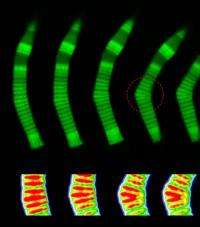Study of how eye cells become damaged could help prevent blindness

Light-sensing cells in the eye rely on their outer segment to convert light into neural signals that allow us to see. But because of its unique cylindrical shape, the outer segment is prone to breakage, which can cause blindness in humans. A study published on January 22nd in the Biophysical Journal provides new insight into the mechanical properties that cause the outer segment to snap under pressure. The new experimental and theoretical findings help to explain the origin of severe eye diseases and could lead to new ways of preventing blindness.
"To our knowledge, this is the first theory that explains how the structural rigidity of the outer segment can make it prone to damage," says senior study author Aphrodite Ahmadi of the State University of New York Cortland. "Our theory represents a significant advance in our understanding of retinal degenerative diseases."
The outer segment of photoreceptors consists of discs packed with a light-sensitive protein called rhodopsin. Discs made at nighttime are different from those produced during the day, generating a banding pattern that was first observed in frogs but is common across species. Mutations that affect photoreceptors often destabilize the outer segment and may damage its discs, leading to cell death, retinal degeneration, and blindness in humans. But until now, it was unclear which structural properties of the outer segment determine its susceptibility to damage.
To address this question, Ahmadi and her team examined tadpole photoreceptors under the microscope while subjecting them to fluid forces. They found that high-density bands packed with a high concentration of rhodopsin were very rigid, which made them more susceptible to breakage than low-density bands consisting of less rhodopsin. Their model confirmed their experimental results and revealed factors that determine the critical force needed to break the outer segment.
The findings support the idea that mutations causing rhodopsin to aggregate can destabilize the outer segment, eventually causing blindness. "Further refinement of the model could lead to novel ways to stabilize the outer segment and could delay the onset of blindness," says Ahmadi.
More information: Haeri et al., Modeling the Flexural Rigidity of Rod Photoreceptors, Biophysical Journal (2013), dx.doi.org/10.1016/j.bpj.2012.11.3835
















